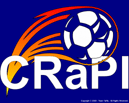|
¤ Wednesday, May 28, 2003
Simulated
RoboCup - Creating a generic API
The field of simulated RoboCup is still in its
infancy, the lack of a stable, well-documented and public API is
apparent. This report describes the effort to provide such an API
to the RoboCup community. The ambition have been to keep the API
agent architecture independent to allow for all possible types of
decision makers to be built on top of it.
Due to the inherent noise in the domain, we set
out designing the positioning functionality with the use of fuzzy
logic. The complexity of this approach, and its inability to keep
reasonable execution times when scaling up from the field size of
the legged league to the field size of the simulated league, forced
us to discard this approach in favour of the simplified positioner
now present in the API.
To enable users to immediately start using the
API, we have created an example player called Tiro. This player
uses the common behaviour model, and can easily be extended to fit
a particular purpose.
¤ Wednesday, June 25, 2003
Machine
learning in simulated RoboCup
Abstract:
An implementation of the Electric Field Approach applied to the
simulated RoboCup is presented, together with a demonstration of
a learning system. Results are presented from the optimization of
the Electric Field parameters in a limited situation, using the
learning system. Learning techniques used in contemporary RoboCup
research are also described including a brief presentation of their
results.
Approved: 2003-06-10
BibTex entry
¤ Monday, June 30, 2003
Situation
assessment and role selection in the simulated RoboCup domain
Abstract:
In the recent world championships of the simulated RoboCup league
the winning teams possessed low level behaviours, such as kick and
pass, that were close to perfection. In order to improve a team’s
performance you will need, beside perfect low level behaviours,
a good management of the team.
We present a model for managing a team in the simulated RoboCup
league.
The model is based on techniques used by the recent winners in the
league and allows you to get a well coordinated team of agents striving
for a common goal.
The model supports different formations in different situations,
which contributes to a dynamic team play, where the players can
adjust to their opponents and other factors like time left and goal
difference. For example if the game is near the end and the team
is loosing a more risky and aggressive tactic is chosen.
Approved: 2003-06-10
BibTex entry
|
